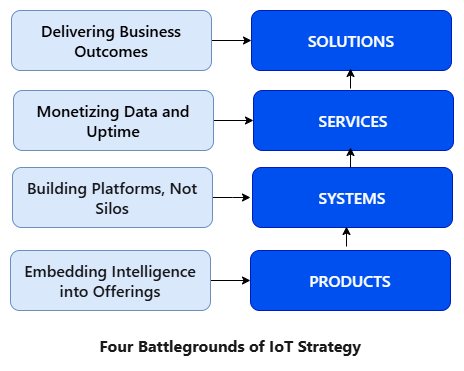IoT Strtaegy

🔁 The Four Battlegrounds of IoT Strategy: A Blueprint for Industrial Transformation
In the era of cloud, AI, and connected everything, traditional industries are undergoing a silent revolution. No longer content with just selling physical products, industrial giants are embracing data, platforms, and intelligence to unlock new value streams.
In this article, I’ve contextualized these four battlegrounds for today’s IoT-driven organizations—and how leaders can use them as a strategic roadmap.
⚔️ 1. Products: Embedding Intelligence
The Shift: From selling hardware to offering smart, connected products.
Smart products are the first step in digital transformation. They are no longer “dumb” assets but intelligent entities—capable of sensing, analyzing, and acting.
IoT Strategy in Action:
- Embed sensors and microcontrollers into machinery.
- Enable real-time telemetry and remote diagnostics.
- Use AI models to deliver predictive maintenance or optimization.
💡 Example: A connected compressor that alerts field teams before failure, reducing unplanned downtime.
⚔️ 2. Systems: Building Platforms, Not Silos
The Shift: From standalone devices to interconnected systems.
Once products are connected, the next leap is to build platforms that allow various components to interact, share data, and create network effects.
IoT Strategy in Action:
- Build unified data platforms and digital twins.
- Integrate edge computing for low-latency analytics.
- Create APIs and SDKs for partners and developers.
💡 Example: A factory operating system that integrates all production machines, HVAC, and energy meters into one dashboard.
⚔️ 3. Services: Monetizing Data and Uptime
The Shift: From one-time sales to recurring service revenue.
Data from connected systems unlocks the ability to offer services around performance, availability, and compliance—moving revenue models from CapEx to OpEx.
IoT Strategy in Action:
- Offer “as-a-service” models (e.g., Equipment-as-a-Service).
- Use ML to deliver anomaly detection or optimization services.
- Define SLAs and service tiers backed by real-time data.
💡 Example: A logistics provider using vehicle sensor data to deliver route optimization as a monthly subscription.
⚔️ 4. Solutions: Delivering Business Outcomes
The Shift: From tools to transformation.
The highest level of value creation comes when you stop selling products or services—and start selling outcomes.
IoT Strategy in Action:
- Orchestrate IoT, cloud, and domain expertise into turnkey solutions.
- Partner with ecosystem players to deliver results.
- Reframe messaging around customer KPIs (not features).
💡 Example: An agritech firm delivering “30% yield improvement” using soil sensors, crop analytics, and satellite imagery—all as one bundled solution.
🧠 Strategic Takeaways for Digital Leaders
To lead in this new era, organizations must:
- Audit where they stand across the Four Battlegrounds.
- Build cross-functional teams aligned to each battleground.
- Develop KPIs tied to services, data, and customer outcomes—not just units shipped.
💬 Final Thoughts
The Four Battlegrounds are more than a theoretical framework—they’re a practical roadmap for reimagining industrial business models in the age of AI and IoT.
If you’re leading digital transformation, ask yourself:
“Are we still selling products, or are we delivering outcomes that matter?”
The answer to that question defines your competitive edge.
Let’s Connect If you’re navigating a similar journey in IoT, cloud, or AI integration—let’s connect. I’d love to hear how you’re applying these ideas in your industry.